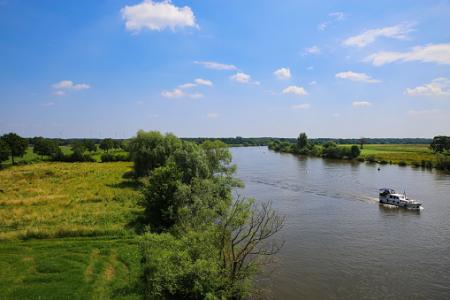
Area characterisation:
The Border Meuse is the only gravel river in the low countries. Because it is a rain-fed river, the discharges can fluctuate greatly: low discharges of 10 m³/s occur during long dry periods, but during an extreme high water, 3,000 m³/s can roar through the Border Meuse. Under such conditions, the river is able to transport large quantities of gravel and sand. The project area is the 50-km-long, unimpeded section of the Border Meuse on the Belgian-Dutch border between Maastricht and Maaseik.
Objective:
The so-colled Border Meuse or "Grensmaas" Project has three main objectives: reduce flood risk, healthier and more diverse nature, and the commercial benefit of both gravel extraction and nature-based economic development.
Financing:
No information
Potential impacts/benefits:
- Flow and flood dynamics: The recovery of river dynamics is occuring as predicted, with major changes in the zones of river bed widening. Sedimentation and erosion create natural bedform of gravel bars and islands. The gravel is mainly deposited in and directly next to the bed at locations where the river changes from narrow to wide.
- Connectivity: the restored connectivity along the river allows for migration and colonisation for a wide range of species in both aquatic and terrestrial groups.
- Shifting mosaics: thanks to the resulting variation in the landscape, natural habitats occur in biodiversity richness.
- Rewilding & natural grazing: from the start of the project, natural grazing has been one of the pillars of the River Park. It occurs in an increasement of species, such as horses, cattle, beavers, roe deers and wild boars.
- Natural area: with some 1,500 ha of relatively wild nature, the Meuse Valley River Park is a growing nature core on the Dutch and Flemish sides of the river.
The river restoration project benefits in attracting over 2 million visitors a year, with a regional economy turning to this new source of income. The project not only has a documented economic added-value, it is also highly accepted in the region. A survey in spring 2021 revealed a 90% high positive valuation for the large river restoration, with 87% of the respondents taking profit of the new area for walking and biking. Furthermore, with the recent unprecedented flood event of July 2021, the combination of river bed widening and nature restoration proved successful in reaching the flood protection targets, keeping the villages safe and dry.
Actions:
- Surveyed restoration sites: through a combination of broadening the stream channel, lowering the floodplain and storage of floodplain top soils in clay shields to protect the groundwater levels.
- Gravel augmentation and gravel pit integration: The gravel augmentation from the Flemish banks amounts some 400,000m³ of gravel. Existing gravel pits were integrated into the river system by lowering the banks.
Contacts:
No information
Global goals:
-
13. Climate action
-
14. Life below water
-
15. Life on land
-
17. Partnerships for the goals
NBS goals:
- Restoring ecosystems and their functions
- Improving risk management and resilience
- Multi-functional nature-based watershed management and ecosystem restoration
- Nature-based solutions and the insurance value of ecosystems
NBS benefits:
- Flood peak reduction
- Reduce flood risk
- Improve connectivity and functionality of green and blue infrastructures
- Increase achievements of biodiversity targets
- Increase Biodiversity
- Increased cultural richness and biodiversity
- Increase communities’ sense of ownership
- Social inclusion
Further information:
In 1990, ARK/WWF started the first nature restoration pilot areas on both sides of the border. A pilot project for river widening was carried out in 2000 near Meers. Finally, in 2008 the large-scale implementation of the Border Meuse project was embarked on. The work will be completed in around 2027.